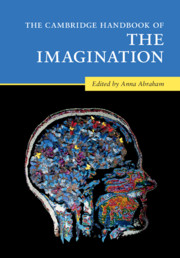Book contents
- The Cambridge Handbook of the Imagination
- The Cambridge Handbook of the Imagination
- Copyright page
- Dedication
- Contents
- Figures
- Contributors
- Acknowledgments
- 1 Surveying the Imagination Landscape
- Part I Theoretical Perspectives on the Imagination
- Part II Imagery-Based Forms of the Imagination
- Part III Intentionality-Based Forms of the Imagination
- Part IV Novel Combinatorial Forms of the Imagination
- 27 On the Interaction Between Episodic and Semantic Representations – Constructing a Unified Account of Imagination
- 28 How Imagination Supports Narrative Experiences for Textual, Audiovisual, and Interactive Narratives
- 29 Development of the Fantasy-Reality Distinction
- 30 Imagining the Real: Buddhist Paths to Wholeness in Tibet
- 31 Hypothetical Thinking
- 32 The Counterfactual Imagination: The Impact of Alternatives to Reality on Morality
- 33 A Look Back at Pioneering Theories of the Creative Brain
- Part V Phenomenology-Based Forms of the Imagination
- Part VI Altered States of the Imagination
- Name Index
- Subject Index
- References
27 - On the Interaction Between Episodic and Semantic Representations – Constructing a Unified Account of Imagination
from Part IV - Novel Combinatorial Forms of the Imagination
Published online by Cambridge University Press: 26 May 2020
- The Cambridge Handbook of the Imagination
- The Cambridge Handbook of the Imagination
- Copyright page
- Dedication
- Contents
- Figures
- Contributors
- Acknowledgments
- 1 Surveying the Imagination Landscape
- Part I Theoretical Perspectives on the Imagination
- Part II Imagery-Based Forms of the Imagination
- Part III Intentionality-Based Forms of the Imagination
- Part IV Novel Combinatorial Forms of the Imagination
- 27 On the Interaction Between Episodic and Semantic Representations – Constructing a Unified Account of Imagination
- 28 How Imagination Supports Narrative Experiences for Textual, Audiovisual, and Interactive Narratives
- 29 Development of the Fantasy-Reality Distinction
- 30 Imagining the Real: Buddhist Paths to Wholeness in Tibet
- 31 Hypothetical Thinking
- 32 The Counterfactual Imagination: The Impact of Alternatives to Reality on Morality
- 33 A Look Back at Pioneering Theories of the Creative Brain
- Part V Phenomenology-Based Forms of the Imagination
- Part VI Altered States of the Imagination
- Name Index
- Subject Index
- References
Summary
Few topics in cognitive neuroscience can be said to have spurred intense research interest and vigorous debate as much as the neurocognitive architecture of imagination. Despite the tendency to view imagination as a unitary mental faculty, its multifaceted nature implicates a diverse range of underlying processes. Episodic memory has been ascribed a foundational role in furnishing the contents of mental constructions. By contrast, semantic memory has long been overlooked in the discourse, despite converging evidence of its centrality for all forms of inner mentation. Here, I expand upon the idea that the undifferentiated and flexible nature of semantic memory renders it particularly well suited to support imagination in its many guises. The imagined scenario thus reflects the output of a dynamic process that shifts back and forth along an episodic-semantic continuum, the weighting of which hinges largely upon task demands and integrity of the underlying memory system. Accordingly, the aim of this chapter is to move the focus away from the traditional episodic/semantic dichotomy in favour of a unified account in which episodic and semantic processes coalesce in the service of constructive endeavors.
Keywords
Information
- Type
- Chapter
- Information
- The Cambridge Handbook of the Imagination , pp. 447 - 465Publisher: Cambridge University PressPrint publication year: 2020
References
Accessibility standard: Unknown
Why this information is here
This section outlines the accessibility features of this content - including support for screen readers, full keyboard navigation and high-contrast display options. This may not be relevant for you.Accessibility Information
- 21
- Cited by
